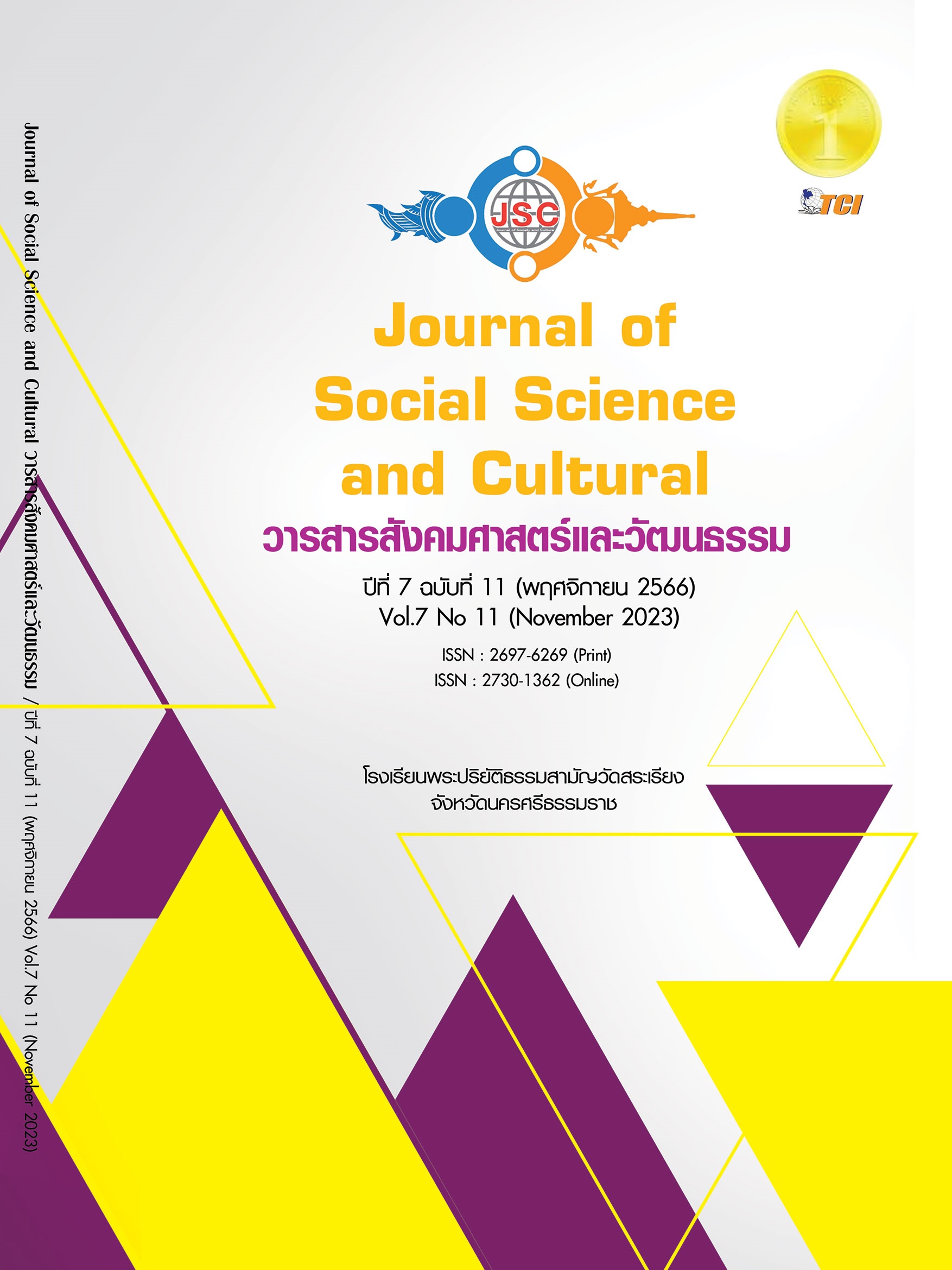ปัจจัยที่มีผลกระทบต่อรายได้จากการท่องเที่ยวของนักท่องเที่ยวชาวต่างชาติ ในประเทศไทย
Main Article Content
บทคัดย่อ
งานวิจัยในครั้งนี้มีวัตถุประสงค์เพื่อศึกษาความสัมพันธ์เชิงดุลยภาพระยะสั้นและระยะยาวของรายได้จากการท่องเที่ยวของนักท่องเที่ยวชาวต่างชาติกับตัวแปรอิสระ 4 ตัวแปร ได้แก่ มูลค่าผลผลิตภาคการเกษตรปริมาณการปล่อยก๊าซคาร์บอนไดออกไซต์ มูลค่าการลงทุนจากต่างประเทศ และผลิตภัณฑ์มวลรวมภายในประเทศแท้จริงเป็นการวิจัยเชิงปริมาณเพื่อสร้างแบบจำลองความสัมพันธ์เชิงดุลยภาพระยาว ข้อมูลที่ใช้ในการศึกษาเป็นข้อมูลทุติยภูมิรายไตรมาส จำนวน 32 ไตรมาส ตั้งแต่ไตรมาสที่ 1 ปี พ.ศ. 2558 ถึงไตรมาสที่ 4 ปี พ.ศ. 2565 ซึ่งเป็นข้อมูลทุติยภูมิจากหน่วยงานต่างๆ นำมาวิเคราะห์สถิติพื้นฐาน การทดสอบสหสัมพันธ์ การทดสอบความนิ่งของของมูล (Unit Root-Test) และแบบจำลอง Autoregressive Distributed Lag (ARDL) ผลการวิจัย พบว่า การวิเคราะห์สหสัมพันธ์ระหว่างตัวแปรอิสระมีค่าสหสัมพันธ์น้อยกว่า 0.8 ไม่ก่อให้เกิดปัญหาตัวแปรอิสระมีความสัมพันธ์กันเอง และการทดสอบความนิ่งของตัวแปรทั้ง 4 ตัวแปรมีความนิ่งมีคุณสมบัติเป็น I(0) สามารถนำตัวแปรทั้งหมดมาวิเคราะห์หาความสัมพันธ์เชิงดุลยภาพระยะยาวได้และเมื่อทำการทดสอบความสัมพันธ์ทั้งในระยะสั้นและระยะยาวพบว่า ปริมาณการปล่อยก๊าซคาร์บอนไดออกไซต์และผลิตภัณฑ์มวลรวมภายในประเทศแท้จริงมีความสัมพันธ์ในระยะสั้นกับรายได้จากการท่องเที่ยวของนักท่องเที่ยวชาวต่างชาติในทิศทางเดียวกัน ส่วนตัวแปรมูลค่าการลงทุนจากต่างประเทศมีความสัมพันธ์ระยะสั้นกับรายได้จากการท่องเที่ยวของนักท่องเที่ยวชาวต่างชาติในทิศทางตรงกันข้ามกัน ส่วนการทดสอบความสัมพันธ์ระยาว พบว่า ปริมาณการปล่อยก๊าซคาร์บอนไดออกไซต์มีความสัมพันธ์ในทิศทางเดียวกันและมูลค่าการลงทุนจากต่างประเทศมีความสัมพันธ์ในทิศทางตรงกันข้ามกันกับรายได้จากการท่องเที่ยวของนักท่องเที่ยวชาวต่างชาติ
Article Details
เอกสารอ้างอิง
กรมการท่องเที่ยว. (2565). รายงานภาวะเศรษฐกิจการท่องเที่ยวรายไตรมาส. เรียกใช้เมื่อ 15 กันยายน 2566 จาก https://www.mots.go.th/more_news_new.php?cid=581
กระทรวงการท่องเที่ยวและกีฬา. (2565). สถานการณ์การท่องเที่ยวปี 2565. เรียกใช้เมื่อ 18 ตุลาคม 2565 จาก https://www.mots.go.th/download/article/article_20220228095455.pdf
ธนาคารแห่งประเทศไทย. (2565). รายงานและสถิติการลงทุนจากต่างประเทศ. เรียกใช้เมื่อ 15 กันยายน 2566 จาก https://www.boi.go.th/index.php?page=statistics_oversea_report_st
สำนักงานนโยบายและแผนพลังงาน. (2565). การปล่อยก๊าซคาร์บอนไดออกไซด์ (CO2) จากการใช้พลังงาน. เรียกใช้เมื่อ 18 ตุลาคม 2566 จาก https://www.eppo.go.th/index.php/th/
สำนักงานสภาพัฒนาการเศรษฐกิจและสังคมแห่งชาติ. (2565). ผลิตภัณฑ์มวลรวมในประเทศรายไตรมาส. เรียกใช้เมื่อ 15 กันยายน 2566 จาก https://www.nesdc.go.th/article_attach/00_QGDP-CVMBook.pdf
สำนักงานสภาพัฒนาการเศรษฐกิจและสังคมแห่งชาติ. (2565). รายงานสภาวะเศรษฐกิจ. เรียกใช้เมื่อ 18 ตุลาคม 2566 จาก https://www.nesdc.go.th/main.php?filename=index
Drisakis, N. (2011). Demand for Money in Hungary: an ARDL Approach. Review of Economics and Finance, 5(1), 1-28.
Fan, Y., et al. (2021). Does Tourism Increase CO2 Emission and Health Spending in Mexico? New Evidence from Nonlinear ARDL Approach. International Journal of Health Planning and Management, 10(1002), 1-16.
Fareed, Z., et al. (2018). Nexus of Tourism, Terrorism, and Economic Growth in Thailand: New Evidence from Asymmetric ARDL Cointegration Approach. Asia Pacific Journal of Tourism Research. Retrieved August 15, 2023, from https://www.researchgate.net/profile/Farrukh-Shahzad5 /publication/328196004
_Nexus_of_tourism_terrorism_and_economic_growth_in_Thailand_new_evidence_from_asymmetric_ARDL_cointegration_approach/links/5ceae0c492851c4eabc11232/Nexus-of-tourism-terrorism-and-e
Johansen. S. (1995). Likelihood-Based inference in Cointegrated Vector Autoregressive Model. Oxford: Oxford University Press.
Lawal, A. I., et al. (2018). Economic growth, Agricultural Output and Tourism Development in Nigeria: An Application of the ARDL Bound Testing Approach. Journal of Environmental Management and Tourism, 4(28), 786-794.
Munir, K. & Iftikhar, M. (2021). Asymmetric Impact of FDI and Exchange Rate on Tourism: Evidence From Panel Linear and Nonlinear ARDL Model. SAGE and Open Access pages. Retrieved August 15, 2023, from https://journals.sagepub.com/doi/pdf/10.1177/21582440211046589
Pesaran, M. H., et al. (2001). Bounds Testing Approaches to Analysis of Level Relationships. Journal of Applied Econometrics, 16(2), 289-326.
Raihan, A. (2023). The Dynamic Nexus Between Economic Growth. Renewable Energy Use, Urbanization, Industrialization, Tourism, Agriculture Productivity, Forest Area, and Carbon Dioxide Emission in The Philippines. Energy Nexus, 9(2023), 1-12.
Raihan, A., et al. (2023). Dynamic Impact of Economic Growth, Energy Use, Tourism and Agricultural Productivity on Carbon Dioxide Emission in Egypt. World Development Sustainability, 2(2023), 1-14.
Stevens, J. (1996). Applied Multivariate Statistics for the Social Sciences (3 rd ed.). Mahwah, NJ: Lawrence Erlbaum Associates.
Thao, H., et al. (2021). The Relationship Between Tourism, Foreign Direct Investment, Energy Consumption, Agriculture and Economic Growth: Evidence from Vietnam. Journal of Contemporary Issues in Business and Government, 2(27), 6612-6632.
Ullah I., et al. (2022). Investigating Relationships Between Tourism, Economic Growth, and CO2 Emissions in Brazil: An Application of the Nonlinear ARDL Approach. Frontiers in Environmental Science, 3(10), 1-10.
Yang, Y., et al. (2021). Do Tourism and Institutional Quality Asymmetrically Effects on FDI Sustainability in BIMSTEC Countries: An Application of ARDL, CS-ARDL, NARDL, and Asymmetric Causality Test. Sustainability, 13(2021),1-29.


